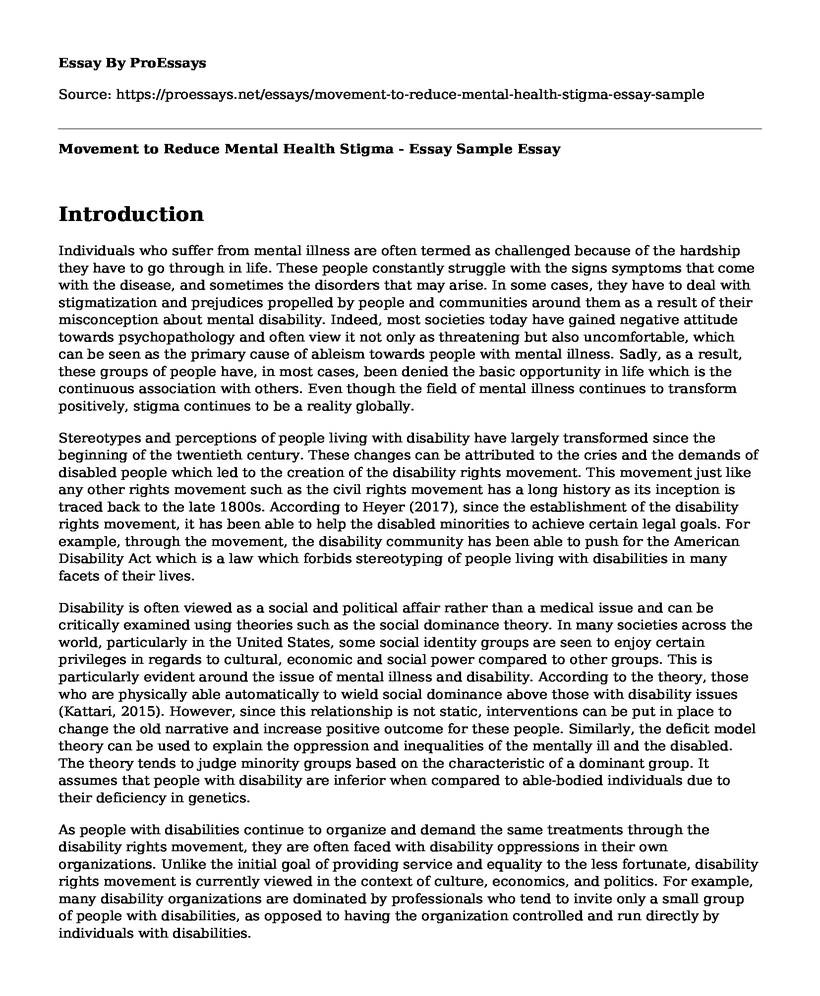Introduction
Individuals who suffer from mental illness are often termed as challenged because of the hardship they have to go through in life. These people constantly struggle with the signs symptoms that come with the disease, and sometimes the disorders that may arise. In some cases, they have to deal with stigmatization and prejudices propelled by people and communities around them as a result of their misconception about mental disability. Indeed, most societies today have gained negative attitude towards psychopathology and often view it not only as threatening but also uncomfortable, which can be seen as the primary cause of ableism towards people with mental illness. Sadly, as a result, these groups of people have, in most cases, been denied the basic opportunity in life which is the continuous association with others. Even though the field of mental illness continues to transform positively, stigma continues to be a reality globally.
Stereotypes and perceptions of people living with disability have largely transformed since the beginning of the twentieth century. These changes can be attributed to the cries and the demands of disabled people which led to the creation of the disability rights movement. This movement just like any other rights movement such as the civil rights movement has a long history as its inception is traced back to the late 1800s. According to Heyer (2017), since the establishment of the disability rights movement, it has been able to help the disabled minorities to achieve certain legal goals. For example, through the movement, the disability community has been able to push for the American Disability Act which is a law which forbids stereotyping of people living with disabilities in many facets of their lives.
Disability is often viewed as a social and political affair rather than a medical issue and can be critically examined using theories such as the social dominance theory. In many societies across the world, particularly in the United States, some social identity groups are seen to enjoy certain privileges in regards to cultural, economic and social power compared to other groups. This is particularly evident around the issue of mental illness and disability. According to the theory, those who are physically able automatically to wield social dominance above those with disability issues (Kattari, 2015). However, since this relationship is not static, interventions can be put in place to change the old narrative and increase positive outcome for these people. Similarly, the deficit model theory can be used to explain the oppression and inequalities of the mentally ill and the disabled. The theory tends to judge minority groups based on the characteristic of a dominant group. It assumes that people with disability are inferior when compared to able-bodied individuals due to their deficiency in genetics.
As people with disabilities continue to organize and demand the same treatments through the disability rights movement, they are often faced with disability oppressions in their own organizations. Unlike the initial goal of providing service and equality to the less fortunate, disability rights movement is currently viewed in the context of culture, economics, and politics. For example, many disability organizations are dominated by professionals who tend to invite only a small group of people with disabilities, as opposed to having the organization controlled and run directly by individuals with disabilities.
Conclusion
In conclusion, stigma continues to become a reality despite the recent changes in the field of mental illness and disability. Luckily, these people have been able to establish movements that help them address their issues. Evidence shows that there are different theories explaining the oppression and inequalities experienced by people with disabilities. However, there are certain professional oppressors that hinder their success in their own organizations.
References
Heyer, K. C. (2017). The ADA on the road: Disability rights in Germany. In Law and Social Movements (pp. 199-238). Routledge.
Kattari, S. K. (2015). Examining ableism in higher education through social dominance theory and social learning theory. Innovative Higher Education, 40(5), 375-386.
Cite this page
Movement to Reduce Mental Health Stigma - Essay Sample. (2022, Dec 17). Retrieved from https://proessays.net/essays/movement-to-reduce-mental-health-stigma-essay-sample
If you are the original author of this essay and no longer wish to have it published on the ProEssays website, please click below to request its removal:
- Paranoid Schizophrenia Treatment Goals
- The Effect of Involvement in Team Sports on Adolescent Development Essay
- A Discussion on Attention Deficit Hyperactive Disorder Paper Example
- Train Mental Health Professionals for Treating PTSD: APA's Clinical Practice Guideline - Essay Sample
- Essay on Cross-Cultural Communication in Romantic Relationships: A Study of Early Stages
- Essay Example on Music: Life's Necessity for Moods & Vibes
- Mary Shelley Frankenstein - Essay Sample







